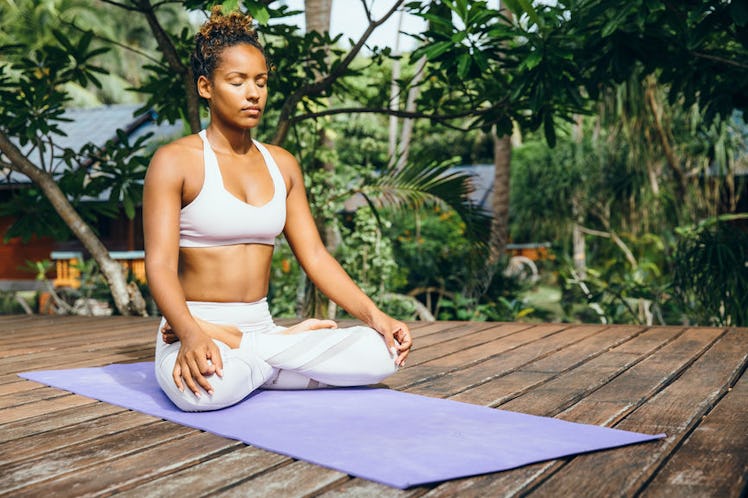
Experts Reveal How You Should Breathe During Yoga, Because It's More Than Just Inhale, Exhale
Like sleep, filling your lungs with air is something humans come out of the womb knowing how to do. Yet, even though a simple breath is the foundation of life, breathing can be done in many forms — and it can even be done incorrectly. Just as it is in life, breathing is also the foundation of an enriching yoga practice. Whether you practice at home or in a studio, it’s not a bad idea to recognize how to breath during yoga. Not only will this be so beneficial to your practice, but it's a skill you can utilize off the mat as well.
As far as Kyle Michaud, a yoga and wellness expert, and the founder of Experience Expositions, a consumer festival company that produces the annual Yoga Expo in Los Angeles and Ft. Lauderdale, is concerned, breath control, or pranayama in Sanskrit, is the most important part of your physical yoga practice. Breathing, he tells Elite Daily over email, strengthens the connection between the mind and body, promoting balance, sound judgement, a steady state of mind, and strong will power.
Breathing is also “very calming for the mind,” Michaud adds, in that when your mind is racing, you can redirect your attention and energy towards your breath. “You can breathe right into spots that hurt and calm that area,” Michaud explains, adding that breath is “also important for the respiratory system” as the respiratory system “is the gateway to purifying the body, mind, and intellect.”
While yoga is often considered a meditative practice, it simultaneously acts as a breathing exercise, but the two components seamlessly intertwine to create the mind-body experience yogis know and rave about. The key to breathing in yoga is to breathe with intention, with mindfulness — and that ties into the meditative aspect. Sometimes you have to separate yourself from your thoughts and focus on your body so that when you return to the busyness, you can do so with a clear head. Make sense?
Now that you have a better idea of why paying attention to your breath is such a vital part of yoga, let’s circle back to the question of how to breathe during yoga, because it’s not as simple as the standard pattern of inhale, exhale. In fact, Keith Allen, yogadownload.com contributor and top yoga instructor, tells Elite Daily that there are actually a number of breathing techniques yogis take on throughout their practice. When they utilize them ultimately depends on the flow and the poses they're performing.
During an exclusive interview with Elite Daily, Allen breaks down the five most commonly used breathing techniques in yoga: Ujjayi, lion’s breath, breath of fire, bhramari, and belly breath. Ujjayi is a “textured, audible breath” in through the nose for six counts and out through the nose for six counts. This breath is used to “create inner heat,” Allen says, as can be used “in every single pose for more depth, steadiness, and a sense of calm.” Lion’s breath is fiercer, with a deep inhale through the nose, and a loud exhale through the mouth with your tongue sticking out. According to Allen, lion’s breath is “meant to be done until you're empty of air at the bottom of the exhale,” in order to release this “stagnant energy out of the body.”
Bhramari and belly breaths are both calming techniques. Bhramai is often performed at the beginning of practice to establish that sense of clarity from the beginning, and requires you to exhale for as long as possible while making a buzzing sound — almost like a bee — so that you can feel the vibration throughout your entire body, Allen tells Elite Daily. Belly breaths, he explains, are taken at a slower pace, and can be taken in any position. Lastly, the breath of fire accomplishes the opposite. Typically performed anywhere from 30 to 100 times in a row, this technique “tones the abdominals, fires up the digestive system, and creates heat that can even make you sweat.”
Now, if you aren't a seasoned yogi, you may not have realized just how vital breathing techniques are to an overall healthy, effective yoga practice. Paying close attention to your breath does so much more than clear the mind — it also balances your levels of oxygen and carbon dioxide in the blood so that you don't pass out, Michaud points out. Totally nonchalant, right?
Think of it this way, if you hold your breath or aren’t controlling your breathing during yoga, "your muscles will tighten," which basically defeats the purpose of yoga. What's more, breathing during yoga keeps you focused on inhalations, full pauses, exhalation, and empty pauses, Michaud points out. In other words, when you're focused on breathing techniques, you aren't focused on any feelings of anxiety.
Bottom line: Yoga breathing techniques are meant to keep you present during your practice, so that as soon as you hit the mat, nothing else matters. It's just you and your flow — the rest of the world can wait.